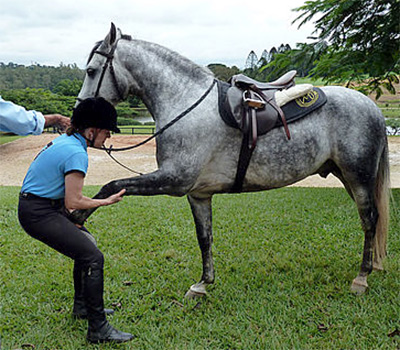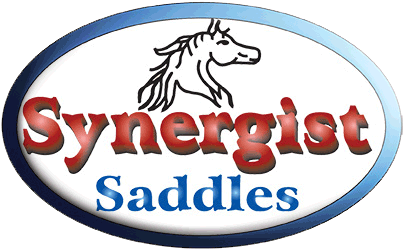A major concern of many riders is how we can fit a saddle behind the shoulder blade of a horse but not interfere with its motion at the same time. It is well known that the back corner of the shoulder blade rotates down and back each time the front leg is extended forwards.
 Some people will lift the front leg and extend it forwards until the forearm (the radius, the bone immediately above the knee joint) is horizontal with the ground to show just how far the shoulder blade moves back. Using this method the shoulder blade will move back 3-4 inches. But this is unrealistic. A horse during normal movement almost never lifts his leg until the forearm is horizontal to the ground. Realistically during normal motion it only moves back 1-2 inches.
Some people will lift the front leg and extend it forwards until the forearm (the radius, the bone immediately above the knee joint) is horizontal with the ground to show just how far the shoulder blade moves back. Using this method the shoulder blade will move back 3-4 inches. But this is unrealistic. A horse during normal movement almost never lifts his leg until the forearm is horizontal to the ground. Realistically during normal motion it only moves back 1-2 inches.
So when we look at the saddle’s effect on the shoulders we don’t want the muscle to be squished between the shoulder blade and saddle. That could cause muscle damage and atrophy. We’ve all seen horses with very prominent shoulder blades with a deep pocket right behind the shoulder blades where the saddle sits. Several studies have shown that it is possible to have muscle damage and atrophy without any signs of damage to the skin covering the muscle. Just because there are no white hairs present doesn’t mean there isn’t muscle damage.
So we know the shoulder blade is coming back and under the front edge of the saddle so what can we do as saddle makers to accommodate the moving shoulder blade? First keep in mind that when the leg is forward and the shoulder blade is at its farthest rearward position, this is when the leg is off of the ground with no weight on it. At this point there is little pressure between the shoulder blade and the tree. As the hoof comes down to contact the ground the shoulder blade is moving forwards and is almost upright when weight is taken on the front leg again.
Another thing to remember is that a horse’s front leg is connected to the main skeleton by a sling of muscles. Our arms are connected to the skeleton via the collar bone which is a very rigid connection. The horse’s shoulder blade is able to move in all 3 dimensions. In, out. Up, down. Back, forwards or any combination thereof. There is no central pivot point. So as the shoulder blade comes back the horse can let it move in towards the rib cage moving away from pressure.
 As a saddle maker we need to make sure the bar tip of the tree is properly designed. The front of the bar of the tree needs to be flared or rounded towards the front with a gentle curve so instead of the shoulder blade bumping into the front of the tree it is directed to slide underneath. Because the shoulder blade is not solid in reference to the rib cage the shoulder blade actually angles its way under the front of the tree. The front part of the blade moves out from the body as the back edge off the blade moves in towards the rib cage.
As a saddle maker we need to make sure the bar tip of the tree is properly designed. The front of the bar of the tree needs to be flared or rounded towards the front with a gentle curve so instead of the shoulder blade bumping into the front of the tree it is directed to slide underneath. Because the shoulder blade is not solid in reference to the rib cage the shoulder blade actually angles its way under the front of the tree. The front part of the blade moves out from the body as the back edge off the blade moves in towards the rib cage.
So a properly designed bar tip will guide the back of the shoulder blade under the bar during the time the leg is extended to its farthest forward position. Because there is no weight on the limb at this point the muscle is not compressed under the saddle. By the time the leg is supporting weight again, the shoulder blade has rotated forwards and out from under the front of the tree. This is how the saddle can sit right behind the shoulder blade and not cause damage or even interfere with the motion of the horse.
So how much flare should be in the front tips of the tree? This depends entirely on the individual horse. A horse with clearly defined shoulder blades and a big drop off to the rib cage is going to need more flare than a horse with a less defined shoulder blade and a flatter transition to the rib cage. Not enough curve and the shoulder can’t move under the saddle comfortably. Too much flare can be just as bad as not enough. If there is too much flare it’s the same as putting too much rock at the very beginning of the tree. If it’s too open in the front the saddle will want to rock forwards and will tend to slide forward on downhills.
